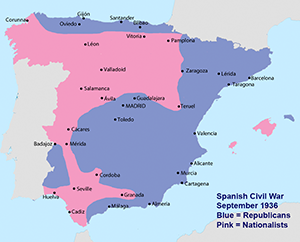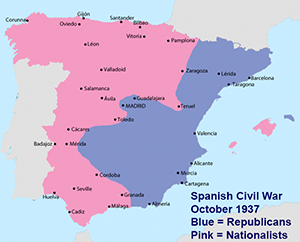The Spanish Civil War
Part 2: The War Begins
By the summer of 1936, plans were in place to topple the government. The flashpoint was the assassination on July 13 of the far-right political leader José Calvo Sotelo. The revolution began in earnest on July 18. A secret plane flew Franco to Morocco, to head up the army there. That group spearheaded the drive for a military takeover on the mainland. The Spanish navy had refused to take part in the uprising, and so Franco's troops had to depend on transport from planes provided by Germany and Italy, both of which found ideological agreement with the Spanish Nationalists and both of which had sent military weapons and equipment. Meanwhile, in the north, General Emilio Mola commanded a Nationalist force bent on absorbing all points south to Madrid. 
Once other rebels took Seville, Franco's troops swooped in and took Cádiz. The Nationalist forces scored a few early wins but did not land a knockout. As well, Republican forces eliminated a handful of the rebels' top leaders and commanders:
By October, Franco had been identified as head of state and had set up a rival government in Burgos. The leader of the elected government by this time was Francisco Largo Caballero. In terms of territory won and lost, by September 1936, Nationalist armies had seized Pamplona, Valladolid, Salamanca, and much of the north and had carved out a swath of territory that looked somewhat like the U.S. state of Florida. 
The rebel force had more men, more weapons, and more friends. Still, government forces held much territory, including Madrid, in 1937. Juan Negrín had replaced Caballero as head of the government. By this time, the conflict had emerged as a clash of supporters of opposing political ideologies. Declaring support for the beleaguered Republic were Mexico, which sent money and weapons, and the Soviet Union, which sent troops, tanks, and many military advisors. France, the United States, and the United Kingdom were officially neutral, but a large number of people from both countries (including the writer George Orwell) made their way to Spain and fought for the government, as part of the International Brigades. (Also fighting in these brigades were people from Albania, Argentina, Belgium, Canada, Cuba, France, Ireland, Italy, and the Netherlands.) Next page > Devastation and Victory > Page 1, 2, 3 |
|
Social Studies for Kids
copyright 2002–2025
David White



 In 1936, the Popular Front, a leftist political party, won the general election, by a narrow margin. The prime minister and then president was Manuel Azaña (left), a journalist and politician who had expressed a strong preference for the Allied side during World War I and had spoken out against the Rivera dictatorship. Rightist groups called foul and vowed to overthrow
In 1936, the Popular Front, a leftist political party, won the general election, by a narrow margin. The prime minister and then president was Manuel Azaña (left), a journalist and politician who had expressed a strong preference for the Allied side during World War I and had spoken out against the Rivera dictatorship. Rightist groups called foul and vowed to overthrow  the government. Soon, many in the military were making the same vow. The government responded by reassigning a handful of prominent generals, including Franco (right), who was given oversight of the Balearic Islands, and Emilio Mola, who was removed as head of the army and sent to Navarre to be commander in Pamplona.
the government. Soon, many in the military were making the same vow. The government responded by reassigning a handful of prominent generals, including Franco (right), who was given oversight of the Balearic Islands, and Emilio Mola, who was removed as head of the army and sent to Navarre to be commander in Pamplona.
